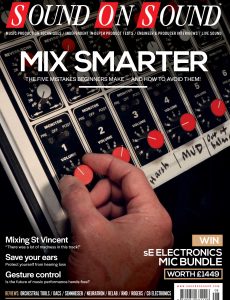
Sound On Sound UK – August 2021
English | 166 pages | pdf | 62.16 MB
Writers like Malcolm Gladwell argue that talent is a myth. What separates the successful from the also-rans, they say, is practice. The ability you are born with is far less significant than the effort you put in. If you spend enough time doing something, eventually — perhaps after the oft-quoted figure of 10,000 hours — you’ll get to be good at it. This can’t be true in all spheres of life, but I’m pretty certain that it’s true for audio engineering and music production. The most important factor in the development of a good audio engineer is time spent engineering.
One reason for this is that some studio skills fall into the category of ‘tacit knowledge’: expertise that you can’t fully articulate in words. Riding a bicycle is a classic example. There’s no way you could learn to do it by reading books or listening to lectures. You need to get in the saddle and pedal. And the best way you can help someone else to learn is not by telling them how it’s done, but by showing them.
This, I think, is why the big studios of the ’60s, ’70s and ’80s produced so many brilliant engineers and producers. Those studios recorded music all day, every day. If you made it as far as Assistant Engineer at Abbey Road or Olympic, you probably got through your 10,000 hours’ practice in two or three years. And much of that learning involved being shown what to do, by expert mentors such as George Martin or Keith Grant.
Those times won’t come again, and learning production on the job isn’t an option today. If you want to get five figures on your studio odometer now, you have two choices. You can attempt to teach yourself, or you can enroll in a more formal educational setting. Either way, those who are sufficiently committed will find the time, but the challenge for those in the second group is finding trustworthy sources of guidance, feedback and advice.
Not everyone can afford to go to college or university in person, and the quality of online courses can be very variable. But the better ones major on human interaction and detailed feedback, and in this month’s cover feature, we’ve harvested the fruits of this process. Between them, the tutors at HOFA-College have analysed a staggering 21,000 student mixes over the years, all of them based on the same core set of multitrack recordings. This makes them uniquely qualified to identify the ways in which novice mixers most often go astray — and that’s exactly
what they’ve done. Reading their article might take you an hour or so of your time — but if it reduces the 10,000 hours you’d otherwise need to get good, I reckon that will be time well spent!
Download from: